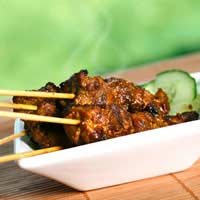Serving an Asian Meal

The especial joy of eating Asian-style is the communal nature of the meal – this is particularly obvious in a Chinese meal but is part of Indian and Thai culture too. It’s something that can be adopted into our everyday way of eating whether we’re eating Asian or not.
In fact a meal can be served that is a mix of a variety of cultures. It might be a good idea, particularly if you lack experience of Asian cooking, for a dinner party, to serve an Asian-style main course (made up of several dishes) with more traditional starters and desserts. As long as you balance the meal so that it’s neither too heavy nor too light, too bland nor too spicy, you can create your own customs.
However if you decide to do a complete dinner party based on an Asian theme then why not follow the traditions of those countries?
The Courses
Variety is the key. For each course - starter, main and dessert - offer a choice of dishes. You’ll only need a little of each – just enough so everyone can taste everything. That may sound like a lot of work, but it won’t be so arduous if some of dishes can be prepared wholly or partly in advance. And because you’ll only need a little of each it means that you can be quite experimental and even if an ingredient is expensive you won’t need much of it.For a Chinese meal, consider serving soup during the meal, to be enjoyed alongside the other dishes, rather than at the beginning.
For dessert, simply lay out a platter of ready-to-eat fruits, maybe accompanied by a chocolate dipping sauce. Try some of the more unusual and exotic fruits as well as the familiar.
Serving
Traditionally all the dishes comprising an Indian main meal are placed on the table together. There isn’t a ‘star’ of the meal; each dish is equally important and has a purpose to serve. The meal will have been carefully planned and balanced to ensure that the aroma and appearance both contrast and complement each other.The wet dishes will be served in bowls while the dry dishes, the flatbreads, pickles and chutneys, will be placed on a thali, or large platter. Everyone helps themselves and then eats using cutlery or torn-off pieces of bread.
It’s similar for both Chinese and Thai meals. The dishes are all laid out at once and everyone helps themselves. On informal occasions serving spoons may be abandoned in favour of chopsticks, with everyone dipping in.
Provide your guests with bowls that they can first fill with rice before taking a little of this or that to add flavour. It’s good manners to take a little at a time allowing everyone the opportunity to sample all the delights of the dinner table. For true authenticity advise your guests to take the dish to the mouth and scoop up the food with chopsticks. Follow this with a drink of soup to cleanse the palate before going back to choose the next sample.
Slurping, sucking and shoveling food are all acceptable!
The Setting
- A round table is very useful for communal meals allowing everyone the same access to the food.
- An Asian meal is a feast for the eyes as well as the tastebuds so choose your tableware to complement the food.
Feasting
- A formal Chinese banquet will be much more elaborate. Many more courses will be served in a strict set order.
- In India almost every day is a feast day for someone! Particular deities require special foods and the feasting will reflect that.
- A Thai banquet will not be complete without an example of the classic Thai royal art of fruit and vegetable carving


Re: Chinese Meat Recipes
All of these recipes sound wonderful! I can't wait to try them. It's about time that I found an asian food recipes website. am looking…
Re: Vietnamese Fish and Seafood Dishes
i like that asian food &i am proud of i am asian
Re: Classic Indian Dishes - Main Courses
This really helped me with my DT - Cooking thanks a lot